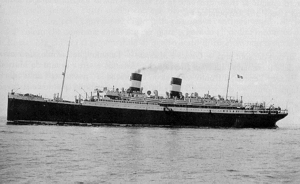SS Roma (1926)
 SS Roma | |
| History | |
|---|---|
| Name: |
|
| Owner: |
|
| Port of registry: |
|
| Builder: | Ansaldo Shipyards, Genoa, Italy |
| Launched: | 26 February 1926 |
| Completed: | September 1926 |
| In service: | 21 September 1926 |
| Fate: | Scuttled, raise scrapped in 1951, completed in 1952 |
| General characteristics | |
| Type: |
|
| Tonnage: | 48,502 GRT |
| Length: | 215.25 m |
| Beam: | 25.20 m |
| Installed power: | Geared steam turbines |
| Propulsion: | Twin screws/quadblades |
| Speed: | 20 knots |
SS Roma was a 30,000 gross register ton ocean liner built for the Italian shipping company Navigazione Generale Italiana of Genoa by Ansaldo shipyard in Sestri Ponente. She was the sister ship to MS Augustus. The ship was later transferred to the new Italian Line after the merger of Navigazione Generale Italiana.
History
Following the end of World War I, many shipping companies were waiting to have enough money to build new liners. Navigazione Generale Italiana ordered two new 30,000 gross tons transatlantic ocean liners to Ansaldo shipyard. The first ship was launched in 1926 and christened Roma. Her interior was decorated in Baroque style.
The Roma was equipped with geared steam turbines, unlike MS Augustus, her sister ship, which was powered by Diesel engines. She had an entirely steel hull, while the engine apparatus, including eight turbines connected in couples to four axes, and whose steam was provided by 13 boilers, allowed her a speed of 22 knots. The ship could house 1700 passengers (375 first, 300 second, 300 intermediate, 700 third class).
Her two funnels were repainted into the Italian Line's colors after her company merged with Lloyd Sabaudo and Cosulich Line to form the new Italian Line. In 1933 the intermediate class was replaced by the touristic one. The main deck was covered with teak.
On 30 January 1932, Roma rammed the American ocean liner President Roosevelt at New York, severely damaging President Roosevelt.[1] President Roosevelt was repaired and returned to service.
Conversion to aircraft carrier
When World War II broke out, she was laid up and later taken over by the Italian Navy. She was then refitted and transformed into an aircraft carrier named Aquila. Her speed was increased to 30 knots after the refitting. She was taken over by the German occupation forces in 1943 but was partially scuttled by Italian Co-belligerents two years later. After the end of the conflict, her wreckage was raised and towed to La Spezia, where she was scrapped in 1951-1952.
See also
References
- ↑ "Casualty reports". The Times (46045). London. 1 February 1932. col F, p. 19.